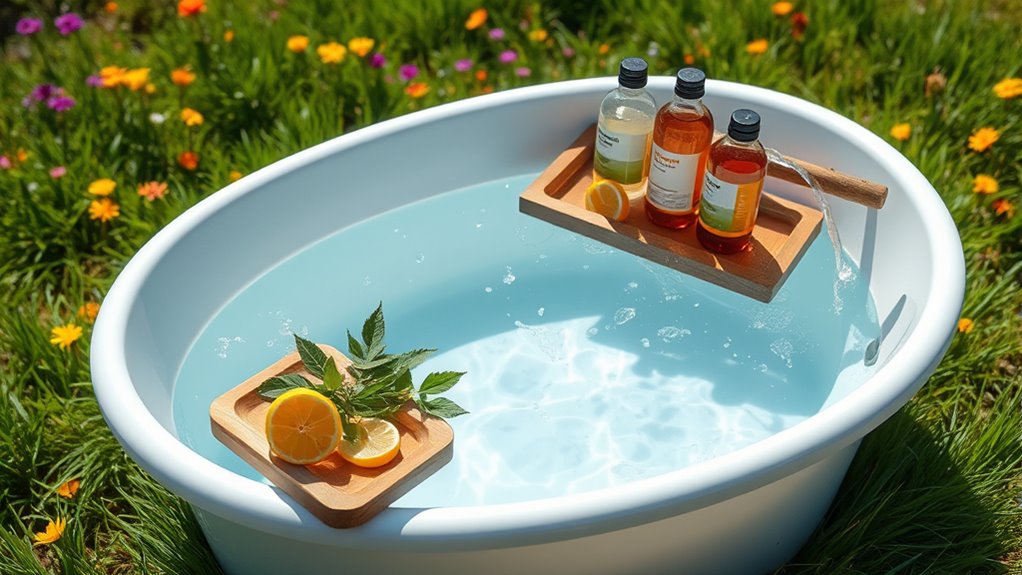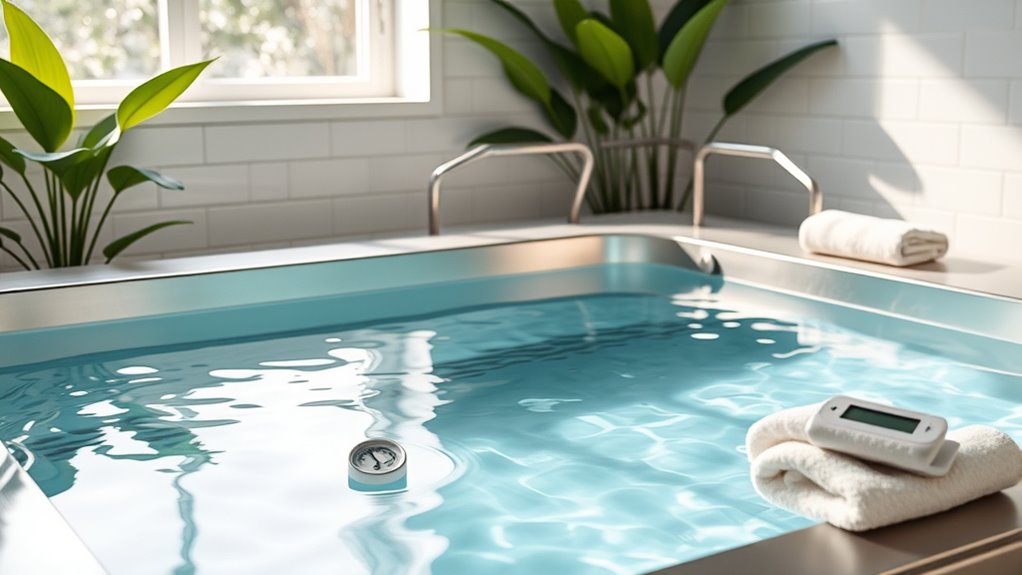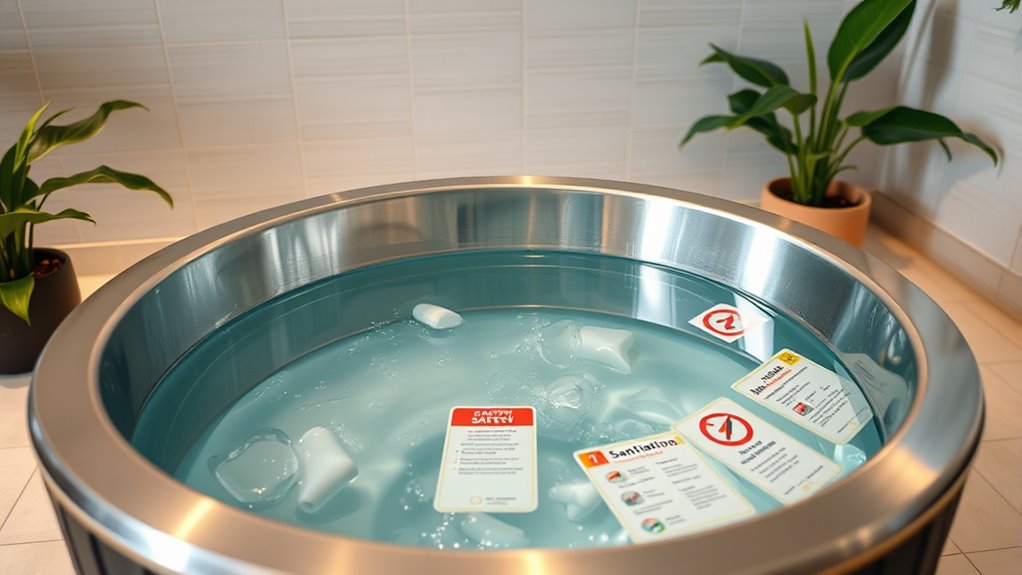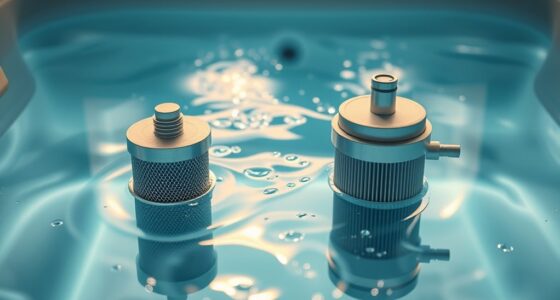Many believe draining and refilling alone keeps your cold tub clean, but that’s a myth. Proper sanitation needs more than just chemicals; it requires correct chlorine levels, circulation, and regular testing. While natural options sound appealing, they often don’t provide reliable hygiene without extra effort. To truly maintain a safe, bacteria-free tub, you need a consistent cleaning routine, water checks, and proper filtration. Keep going to discover the key facts and avoid common misconceptions.
Key Takeaways
- Draining and refilling alone do not ensure proper sanitation; regular cleaning and chemical management are essential.
- Proper pathogen control depends on correct chlorine levels, circulation, and water testing, not just chemical addition.
- Natural sanitation methods like ozonators are eco-friendly but require consistent maintenance and are slower than chemicals.
- Weekly cleaning and filtration checks help prevent bacteria buildup, mold, and residue in cold tubs.
- Showering before use and monitoring water clarity and odor are key practices for safe, hygienic tub use.
Common Misconceptions About Cold Tub Sanitation

Many people believe that simply draining and refilling a cold tub is enough to keep it sanitary, but this isn’t true. There’s a common misconception fueled by chlorine myths that just adding chlorine automatically ensures pathogen prevention. In reality, relying solely on chlorine without proper testing and maintenance can leave harmful bacteria and viruses behind. Chlorine helps control pathogens, but it must be used correctly—maintaining the right levels and ensuring proper circulation. Overlooking other sanitation practices can give a false sense of security. Effective cold tub sanitation involves more than just chemical treatment; it requires regular cleaning, proper chemical dosing, and monitoring to prevent bacteria buildup. Additionally, understanding water chemistry is essential for maintaining a safe and clean environment. Don’t fall for myths—stay informed, and prioritize comprehensive pathogen prevention strategies.
How Often Should You Clean Your Cold Tub?

To keep your cold tub safe and sanitary, regular cleaning is a must. How often you clean depends on usage and water filtration effectiveness. If you use the tub frequently, aim to clean it at least once a week to prevent bacteria buildup. For less frequent use, a bi-weekly cleaning may suffice. The tub material also influences cleaning frequency; porous materials like wood may require more frequent attention than acrylic or plastic tubs. Regular maintenance of your water filtration system is essential to reduce debris and contaminants, extending the time between deep cleans. Always inspect your tub regularly for signs of mold or residue, and clean accordingly. Consistent cleaning guarantees a safe, hygienic environment for every soak, regardless of how often you use your cold tub. Additionally, understanding the contrast ratio of your filtration system can help ensure maximum clarity and safety of the water.
Effective Methods for Maintaining Cleanliness

Maintaining cleanliness in your cold tub involves adopting effective cleaning techniques and using the right tools. Regularly checking and maintaining your water filtration system ensures clean, clear water. Proper hygiene practices, like showering before use, reduce contaminants entering the tub. Change the water periodically to prevent buildup of bacteria and debris. Invest in a good skimmer or net to remove leaves and debris daily. Use a clean brush or cloth to scrub the surfaces, focusing on corners and filters. Filter maintenance, such as replacing cartridges, is vital for peak performance. Consistent practices keep your cold tub hygienic and safe. AI-powered data analysis can support better decision-making in your maintenance routines to ensure optimal cleanliness.
The Truth About Chemicals and Natural Alternatives

Balancing chemical use and natural alternatives in your cold tub can be challenging, but understanding their effects helps you make informed choices. Chemicals like chlorine ensure quick sanitation, but some worry about chemical safety. Natural remedies, such as mineral purifiers or ozonators, offer eco-friendly options, yet may require more maintenance. Knowing the pros and cons helps you choose what fits your needs. Here’s a quick comparison:
| Aspect | Chemicals | Natural Alternatives |
|---|---|---|
| Effectiveness | Fast and reliable | Slower, dependent on proper use |
| Safety | Potential skin and eye irritation | Generally safer, minimal risk |
| Maintenance | Regular chemical checks | Periodic natural treatments |
| Environmental Impact | Can be harmful if misused | Eco-friendly, sustainable |
Understanding these options helps you prioritize chemical safety while enjoying a healthy, clean cold tub. Additionally, being aware of proper sanitation practices can significantly reduce risks associated with both methods.
Tips for Safe and Hygienic Cold Tub Use

Choosing the right sanitation approach is just the first step; guarantee safe and hygienic use of your cold tub requires ongoing attention. Regular water testing helps you monitor levels of hot tub bacteria and other contaminants, keeping your water safe. Maintain proper circulation and filtration to prevent bacteria buildup. Shower before entering to reduce dirt and oils that can compromise water quality. Keep a consistent cleaning schedule, including draining and refilling the tub as needed. Be vigilant about signs of cloudy water, foul odors, or skin irritation, which indicate a need for immediate action. By staying proactive and testing your water frequently, you ensure a hygienic experience every time, reducing health risks and maintaining your cold tub’s longevity.
Regular testing and cleaning ensure your cold tub remains safe, hygienic, and long-lasting.
- Perform regular water testing for bacteria levels
- Clean and filter your tub consistently
- Shower before use to minimize contaminants
- Drain and refill the water periodically
Frequently Asked Questions
Can Homemade Cleaning Solutions Effectively Disinfect Cold Tubs?
DIY sanitizers and natural disinfectants can be effective for cleaning cold tubs if used correctly. You should focus on ingredients like vinegar, baking soda, or hydrogen peroxide, which have natural antimicrobial properties. However, they may not always kill all bacteria or viruses as reliably as commercial disinfectants. Always guarantee proper contact time, and test solutions to confirm they’re safe and effective for your specific cold tub.
Is It Necessary to Drain and Refill the Tub Regularly?
Yes, you should regularly drain and refill your cold tub. Typically, following a consistent drain frequency—about every 4-6 weeks—helps maintain essential sanitation. Your refill schedule depends on usage and water quality, but generally, refilling every 1-2 months ensures fresh water and reduces bacteria buildup. Regular draining and refilling are vital to keep your tub clean, safe, and enjoyable, preventing the spread of germs and maintaining water clarity.
How Does Water Temperature Affect Sanitation Practices?
Think of water temperature as the gatekeeper to your cold tub’s cleanliness. When you keep the temperature well-regulated, it slows down bacteria growth and keeps water chemistry balanced. But if the temperature climbs too high, it’s like opening the floodgates—germs flourish. So, proper temperature regulation is key to maintaining sanitation, reducing the need for frequent draining, and ensuring your tub stays fresh and safe.
Are There Specific Brands of Sanitizers Recommended for Cold Tubs?
Yes, you should look for brands like SpaGuard, Leisure Time, or Crystal Spa, which are well-known for their sanitizer effectiveness in cold tubs. These brands are trusted because their products are specifically formulated to combat bacteria and algae in chilly water. Always check the label to verify the sanitizer is compatible with cold water and follow the manufacturer’s instructions for best results. Proper brand selection helps maintain a clean, safe tub.
What Are the Signs of Poor Sanitation in a Cold Tub?
Think of your cold tub as a mirror reflecting its cleanliness. If you notice algae buildup or foul odors, it’s a sign that sanitation isn’t up to par. These issues indicate bacteria and mold are taking hold, making the water unsafe. Regularly check for cloudy water, slimy surfaces, or a strange smell—these are clear signs you need to step up your cleaning routine to keep your tub safe and inviting.
Conclusion
Keep your cold tub sparkling like a mountain stream, flowing pure and inviting. Bust myths, embrace effective cleaning, and choose what’s right for you—chemical or natural. With simple tips, you’ll turn your tub into a sanctuary of renewal, a haven where clarity and cleanliness dance in harmony. Trust the truth, stay consistent, and watch your cold tub become a refreshing oasis, always ready to rejuvenate your body and mind with every icy splash.









